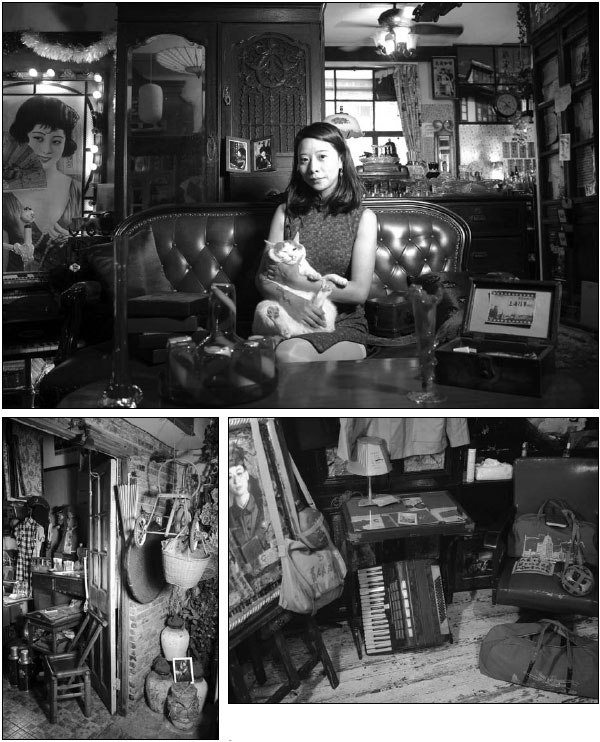
|
Shanghai is a city with an eye to the future - but some residents are nostalgic for times past. Wu Ni chatsto a 'retro-holic' who is collecting pieces of the lost city. For many Shanghai natives, nostalgia is a natural reaction to the rapid and drastic changes that arehappening to the city. Wang Xiaojia went a step further - she built a museum to commemorate the goldendays of old Shanghai. The museum is hidden away in the middle of a residential compound for war veterans. Stepping inside,one is immediately transported into the past, with a nostalgic atmosphere created by the dusky lighting,slow jazz melody and thousands of items reminiscent of old Shanghai. They include qipao, or cheongsam, the popular dress among socialites and upper class women in the1920s in Shanghai, rusty tin boxes for cigarettes, vintage watches and bags, and complete householdarticles used by old Shanghai families from glassware to ashtrays, light bulbs, wash basins, thermoses,sewing machines and wardrobes. Wang named her museum Shanghai 1937, an era in her eyes when the city's prosperity rivaled Parisand New York, but was interrupted by the invasion of the Japanese army. Wang's family has lived in Shanghai for generations. Born in the 1980s, she grew up in a traditionalstone-arched Shikumen lane house. As skyscrapers and shopping malls gradually took over the city, theold houses were demolished, big families dispersed and things that she was familiar with disappeared. She started to collect the old-fashioned items and accumulated so many things that they piled up in astorehouse. Her brother, a photographer, had a vacant photo studio that she thought could be a perfectspace to display her collection. The 200-square-meter studio was transformed into a tiny museum that unexpectedly became a populardestination for those who are fond of local culture and seek old Shanghai flavor. "These exhibits are not expensive or rare, but people feel intimate with them," Wang says. "Visitors arereminded of the times past and beautiful memories." Wang recalls a middle-aged woman who bought a cassette of Fei Xiang, or Kris Phillips, the renownedChinese-American pop icon who was popular on the Chinese mainland in the 1980s. "She said the singer was her idol when she was young but she could not afford the cassette. Now shehad fulfilled her girlhood dream, although the cassette was shabby and the sound quality notsatisfactory," Wang says. Wang works as a stylist but contributes most of her sparetime to the museum. She calls herself a "retro-holic" and isproud that she has saved precious items and their storiesfrom fading from history. On a wall of the museum are a dozen wooden doors shesalvaged from a bulldozer. "I was passing by a constructionsite and saw workers were ready to demolish the houses. Icried out loudly to stop them and said I would take thewooden doors," she recalls. "The doors are no more than 100 years old. They might not be that valuable for antique dealers but theyare precious to me," she says. "Look at those lines and colors, they were sculpted by time." She also has two razors she collected from an old man whose grandfather received them from Americansoldiers, in exchange for food, in the 1940s, when Shanghai was a World War II battlefield. Most exhibits are tradable except for a few personal items. Wang cherishes the pianos she has collectedthe most. The oldest one is an antique Robinson piano dating back to the 1870s that was used in areligious school. The piano keys are made of ivory. A Montrie piano was left by Wang's grandmother. The brand, created by the British and produced inShanghai, was very popular in the 1930s. She also has a Nieer piano, a Chinese produced piano fromthe 1950s. The instrument is simple, and was made without a cover because there was scant access tomaterials in that era. She also has a mini-piano Wang played when she was only a kid. Ann Gu, a 25-year-old Shanghai native, found many exhibits spark memories. "The clothes, bags, vasesand cups, no matter what time they belong to, are exquisite. I think they reveal the pursuit of Shanghaipeople for high-quality and exquisite life," she says. The museum is only open to the public on Saturday afternoons. On otherdays, it is used as a photo studio where customers can dress in the1930s style and pose for photos, or a cute space for friends to haveafternoon tea, or even a small bar where several friends come for a drink.There are plenty of old-fashioned snacks and beverages available here. Wang's brother, who asked to be called by his nickname Lao Hei,explained that the flexible management aims to earn some money tomaintain the museum. He says the collection includes some clothes andnewspapers dating back to a century ago that need to be regularly taken care of. It is not easy for a private museum to survive in the city if it lacks financial support from the governmentor foundations. But the siblings say they will try their best to carry on and hope to find a larger space todisplay the items chronologically. "These exhibits embody what used to be a part of our life. We loved them, commemorate them and wouldlike to introduce them to more people," Wang says. By Wu Ni ( China Daily) |
对很多老上海人而言,面对城市日新月异的变化,怀旧之情不免油然而生。一位八零后上海女孩将这种情感付诸行动,开办了一间独特的老上海怀旧博物馆来纪念往日时光。 这间怀旧博物馆位于上海临潼路一个不起眼的退伍老兵住宅区。一踏入馆内,朦胧的灯光、老式留声机里慵懒的曲调,以及上千件大大小小的老上海物件,立刻将参观者拉回上世纪的上海滩。 这里陈列的老物件有经典的旗袍、铁烟盒、老上海明星画报、古董表、复古包,还有整套的家庭用品,如玻璃器皿、烟灰缸、灯泡、脸盆、热水瓶和缝纫机。 王小佳将这件博物馆命名为上海1937。在她看来,上世纪三十年代,上海的繁华堪比纽约和巴黎,直到1937年日本入侵上海,打破了这种繁荣。 王小佳的家族几代人一直生活在上海,她从小在石库门弄堂里长大。随着摩天大楼和购物商场逐步占据城市,王家的老房子拆迁了,原本生活在一起的亲朋好友们也四散到城市各个角落,她所熟悉的老物件也慢慢消失。 这个从小就喜欢收藏的姑娘开始淘老上海的物件,越积越多,最后不得不堆在一个仓库里。王小佳的哥哥老黑是个摄影师,正好有一间摄影棚空出来,兄妹俩就用这个空间将收藏的老物件一一展出来。 他们将这间200多平米的摄影棚设计成一个微型博物馆。没想到的是,博物馆成了热门,吸引了很多热衷上海文化或寻找老上海感觉的参观者。 “其实我们的展品并不昂贵或罕见,但是人们看到了会感到很亲切,想起从前的美好回忆,”王小佳说。 一位中年女性参观者购买了一盒费翔的磁带,这给王小佳留下了深刻的印象。“费翔是她少女时代的偶像,但那个时候磁带很贵,她买不起,而在这里她圆了少女时的梦想。” 王小佳是一位设计师,但维护这间博物馆占用了她大部分时间,她还给自己取了个外号---旧货囤积症患者。她自豪的是,很多珍贵的老物件都是她从一堆废旧物件中挽救的。 比如怀旧博物馆的一面墙上挂着12扇木制门窗,这是她从推土机下救出来的。“那时候我经过一个拆迁工地,施工的人正要推倒这些木门,我大吼一声:不准动!这些门我要了。”她回忆说。 “这些木门不到100年,对古董商人来说可能并不值钱,但是对我来说很珍贵。你看门上的线条和深浅不一的颜色,这些可都是时光雕刻出来的。” 她津津乐道的还有从一位老人家中收集的两把剃须刀。上世纪四十年代,这位老人的爷爷在大名路的码头用上海食品跟美军士兵交换了这两把剃须刀。 除了一部分王小佳的私人藏品,博物馆的大部分物件是可以交易的,参观者可以购买或者用其他的老物件来交换。 王小佳最珍视的是老钢琴。最老的一台罗宾逊钢琴可以追溯到1870年,钢琴的琴键是象牙制成,供教会学校使用。另外一台摩德利钢琴源于1930年,小佳的奶奶曾经弹过。还有一台上世纪五十年代生产的聂耳牌钢琴---由于物资匮乏,这架钢琴甚至没有琴盖。此外还有她一岁时弹过的小钢琴。 25岁的顾安是地道上海人,很多展出的老物件和她记忆中一模一样,这让她非常感动。“这些瓶瓶罐罐,还有其他的物件,不管属于哪个年代,我觉得都很精致,这和上海人对高品质和精致生活的追求是一致的。” 目前,怀旧博物馆只在周六下午对公众免费开放。在其他时间,这里可以是摄影棚,怀旧爱好者可以身着年代服装,拎着复古包,利用老式场景拍摄照片。感兴趣的参观者可以打电话预约,在这里喝下午茶或者朋友小聚。 王小佳的哥哥老黑解释说,这种灵活的经营模式是出于成本的考虑。很多有百年历史的衣服和报纸需要定期维护,博物馆也要支付租金。确实,维持私人博物馆并不容易。上海的一些小型私人博物馆由于得不到扶助而被迫关门。 不过,这对兄妹表示他们会坚持下去,并希望今后找到一个更大的场所,将这些展品按照年代顺序陈列出来。“这些老物件是我们曾经生活的一部分,我们很喜欢,并希望更多人能了解。” 相关阅读 (中国日报记者吴妮) |